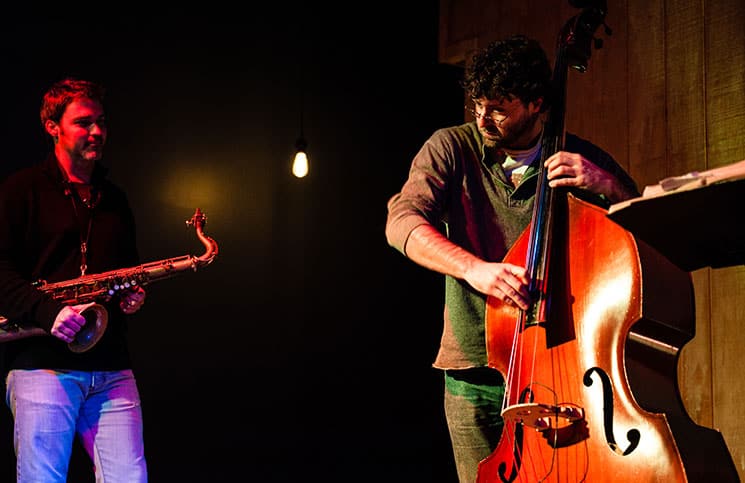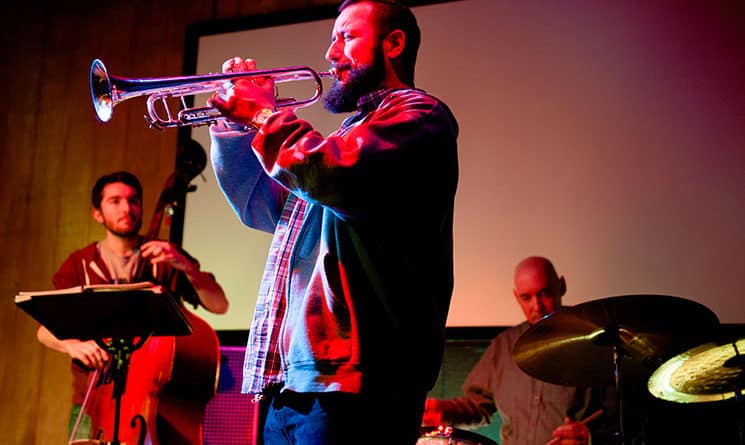Even Chris Klaxton found it difficult to get into jazz. Now one of the most well-known trumpet players in the Seacoast, Klaxton didn’t know what to make of the genre the first time he listened to a John Coltrane record. “What the hell is this?” he thought.
“But the people I loved and respected were into it, so I just kept going back and going back, and finally…” He snapped his fingers to finish the sentence.
While jazz never ceases to surprise musicians and audiences alike, the genre can be daunting for newcomers, Klaxton said.
“(Jazz) takes work and repeated exposure,” he said. “If (a song) doesn’t have lyrics, it’s like a painting that’s not of an object. If there’s a painting of a boat, a skipper, a lighthouse, people are like, ‘Oh, a thing.’ But if it’s an abstract painting, people go, ‘Whoa, what is that?’”
Jazz has deep roots in the Seacoast. Starting with Tommy Gallant’s Sunday night jazz series at The Press Room in the late 1970s, dozens of venues across the region have hosted weekly jazz jams, concerts, brunches, and more. The region has been a way station for traveling musicians headed to Boston or Portland, and jazz greats like trumpeter Clark Terry and others have strong ties to the local scene.
Despite all this, the Seacoast jazz scene waxes and wanes. With the constant turnover of bars and clubs, musicians are forced to migrate from gig to gig at any venue that will take them. Bringing in new, younger audiences is also a challenge.
According to Klaxton and others, though, local jazz is currently experiencing a resurgence, thanks to a handful of supportive venues and a renewed sense of community.
Experimental space
Until it closed its doors in 2013, The Barley Pub in Dover had been one of the most notable jazz hubs in the area, according to locals. It was a place for musicians to perform, have a drink together, and collaborate, all in a casual atmosphere.
“The Barley Pub was a very nurturing environment,” said Stu Dias, singer and guitarist for the Soggy Po’ Boys. “The Po’ Boys would not have existed were it not for The Barley Pub.”
When The Barley Pub closed, musicians who regularly performed there scrambled to find new locations that offered the same type of experimental freedom.
“The Seacoast is running shorter and shorter of places where you can go and test out new projects without having to worry about having a horrible night,” said Dias. “There’s a lot of pressure on a person to always have a good night when they go out and play.”
Dias books the Sunday jazz series at Sonny’s Tavern, which is located in The Barley Pub’s former space. He said he’s done his best to provide a space for local musicians to cut their teeth on new projects.
“People tend to show up because there are no rules,” he said. “So there’s no boundaries on what can happen on one of these nights, and I think that’s weirdly free.”
Around the time when The Barley Pub closed, Klaxton said, it felt as if support for the genre was waning at other venues. So he and others took action to bring new energy to the scene.
“(We were) getting a little older and realizing that venues aren’t going to support you if you don’t make things happen,” Klaxton said. “Because of the lack of venue support, we’ve gone into an exclusively DIY frame of mind. … We went out and started just asking for gigs, and there are venues like The Stone Church (in Newmarket) and Birdseye Lounge (in Portsmouth) that were able to be quite easily convinced that this was a good thing.”
Convincing audiences to come out, though, is another matter.
Pianist Ryan Parker, who books the Sunday jazz series at The Press Room in Portsmouth, said it’s difficult to convince audiences to come out for any type of live music.
“People are staying in much more often now because they can get cheaper entertainment at home,” he said. “One of the problems is actually paying five dollars to see a group of musicians that have a combined 150 years of playing. (Audiences) don’t want to pay.”
Parker said audiences who come out to see jazz are more interested in “special” nights — album release shows, themed performances, tributes to famous musicians. Artists with regional and national reputations, like Gray Sargent or Harry Allen, might pack The Press Room, he said. But, when it comes to local performers, attendance drops.

Bassist Steve Roy (right) joins saxophonist Mark Small and the rest of the band on stage at Birdseye Lounge. photo by Anna Solo
But those special performances can help bring in new, younger audiences, according to Klaxton. Fusing jazz with recognizable pop tunes by artists like David Bowie or Soundgarden opens up audiences to the genre’s possibilities.
The Portsmouth Music and Arts Center recently hosted a jazz night at The Music Hall Loft that celebrated Bowie, while The Dance Hall in Kittery, Maine, hosted a tribute night to jazz great Allen Toussaint.
Drika Overton, The Dance Hall’s founder and executive director, said the venue has emphasized jazz since it opened five years ago.
“I believe that (The Dance Hall) is among the best listening rooms in the region, and if we are overlooked, it is probably because we are in Kittery,” she said. “But that’s OK; Kittery is happening … we’ve got a great groove going over here.”
Playing the future
Parker said the future of jazz may not be in the hands of bars and clubs, but instead in the hands of colleges and universities.
“Now you have Berklee and New England College and others where you can get degrees and you can get a doctorate, and all of a sudden, it’s institutionalized. That might not be a bad thing,” said Parker. “It’s pretty alive and well at colleges, and thank God, because colleges have the ability of fundraising and getting donors to donate to the college. The positive thing that does is spreads (the scene) out like a spider web.”
Many of the Seacoast’s jazz players, including Klaxton, are also educators. Along with the fundamentals, they’re teaching their students and new musicians the basics of networking and hustling for shows.
The University of New Hampshire is playing a role as well. Instructors Mark Shilansky and Les Harris Jr. can frequently be found playing gigs in the area. Having teachers who are active in the scene encourages students to get out and play, too.
Chris Jordan, a guitarist and recent University of Vermont graduate, said that when he moved back to the Seacoast after college, it was relatively easy to get involved in the jazz scene. Within months, he was able to set up a bi-weekly jazz night at The Stone Church and bring together a band of UNH students to perform with him. He’s gotten some advice from Klaxton along the way.
“Sometimes opportunities present themselves, and that’s awesome. But, as young musicians, it’s sort of on us to make an effort to reach out to musicians and people who can help us succeed,” Jordan said. “Most local jazz musicians that I’ve met have been super friendly and helpful. They genuinely want the jazz scene to prosper and continue on, which is a great thing.”
Klaxton agreed.
“That’s what accounts for the current resurgence,” he said. “Many of us playing are teachers, and actually one of the reasons we get people to see us sometimes is because they’re our students and their families. So we’ve become friends with people a few generations older and younger than us

